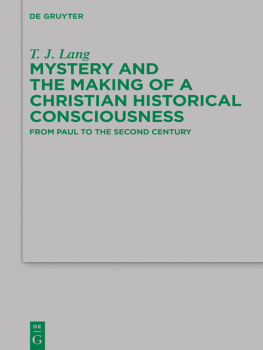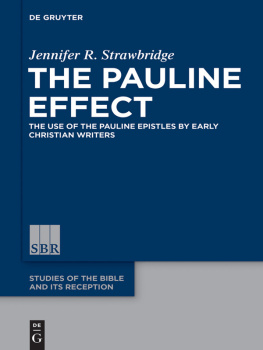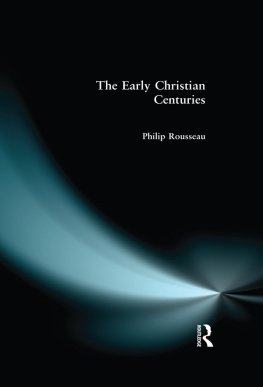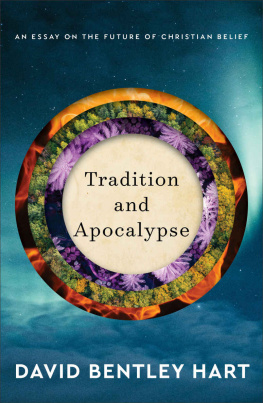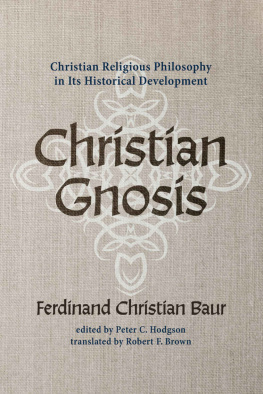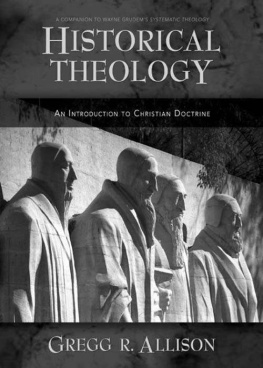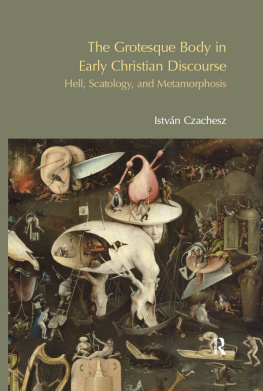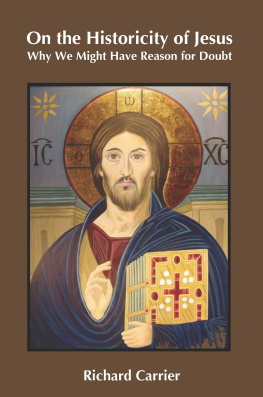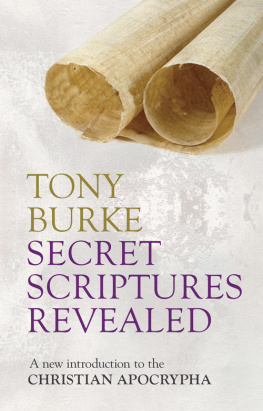Inhaltsverzeichnis
T. J. Lang
Mystery and the Making of a Christian Historical Consciousness
Beihefte zur Zeitschrift Fr die neutestamentliche Wissenschaft
Edited by
Carl R. Holladay, Matthias Konradt,
Hermann Lichtenberger, Judith Lieu,
Jens Schrter and Gregory E. Sterling
Volume 219

ISBN 978-3-11-044267-0
e-ISBN (PDF) 978-3-11-043686-0
e-ISBN (EPUB) 978-3-11-043547-4
ISSN 0171-6441
Library of Congress Cataloging-in-Publication Data
A CIP catalog record for this book has been applied for at the Library of Congress.
Bibliographic information published by the Deutsche Nationalbibliothek
The Deutsche Nationalbibliothek lists this publication in the Deutsche Nationalbibliografie; detailed bibliographic data are available on the Internet at http://dnb.dnb.de .
2015 Walter de Gruyter GmbH, Berlin/Boston
www.degruyter.com
For Penelope, Henry, Theo, and Jessica
Acknowledgements
Acknowledgements hardly seems like the right word for this space in which I express my deep appreciation for the many people, institutions, and sources of funding that have made this book and the life required to write it possible. It seems most fitting to begin my thanks with the person who has put more effort into this project - and indeed my entire career - than anyone else other than me. This would be my adviser, Douglas Campbell. Adviser is a horribly impersonal word for describing our relationship, which is to say our friendship. The thanks I offer here is an insufficient gesture of appreciation for his dedication to me, my family, and my work. More than a Doktorvater, he is my Vorbild.
My entire committee has also been a pleasure to work with and a source of unceasing support. Liz Clark exemplifies scholarly precision and creativity. Richard Hays has pressed me to open up my work to more ambitious claims, and he has given me the courage to do so. Kavin Rowe has been a constant conversation partner. I have worked out many problems on his front porch - or at least I have come to figure out just what the problems are. Although alphabetical order places him last in this list, Warren Smith has had a massive influence on my thinking. Our time together in Uganda is something I shall never forget, which is a promise I also made to the so-often forgotten pastors of South Sudan.
After my committee, Nathan Eubank deserves special mention. Nathan read every word of my first drafts, as he has of almost everything I write, and his comments are always meticulous and, in their most helpful instances, critical. Thanks are also due to the many others who have contributed in specific ways to this project: Hans Arneson, Stephen Carlson, Carl-Magnus Carlstein, Pete Jordan, Greg Lee, Joel Marcus, Lou Martyn, Tom McGlothlin, Sebastian Moll, Jason Staples, Matthew Theissen, Matthew Whelan, and Ben White. Many other names could be added to this list.
I should also acknowledge the institutions and people associated with them that have made this work possible. Duke University is a remarkable place to research and write. Funding from Dukes Graduate School and two Summer Research Fellowships provided the finances enabling me to devote myself unburdened to this book. Thanks are also due to the Fulbright Commission, which provided funding in 2009 -10 for a year of research as a Fulbrighter in Germany at the University of Heidelberg. I express gratitude to my host in Heidelberg, Peter Lampe. Robert Jewett was also a tremendous source of support while in Heidelberg, helping me better formulate some of my early thinking on this project. Last but not least, I acknowledge the Dolores Zohrab Liebmann Fund, which supplied critical financing during the final years of writing.
And finally there is my family. My parents, Tim and Debbie Lang, have always given of everything they have to me and enthusiastically supported my work, even when it is mostly a mystery to them. But it is my wife, Jessica, and our three children, Penelope, Henry, and Theo, who have most patiently endured my daily (and often nightly) labor. As anyone who knows us would attest, little I have done is imaginable without Jessica. To try to indicate my appreciation for her is where words alone fail.
1 Introduction
1.1 Origins
The story of this book (or the initial spark) begins with a lucky literary crossing of wires made possible by the arrangement of the theological library at the University of Heidelberg. While on a Fulbright in Heidelberg in 200910 I began research on what I thought would be an exploration of the reception and development of Pauline hermeneutics up to Origen, who is often considered to be the first self-consciously systematic Christian exegete and is certainly a self-conscious claimant of the Pauline exegetical legacy. I intended to trace the influence of Paul upon Origen and his predecessors, hoping to define with greater precision the apostles importance in the formation of early Christian exegesis. At the time I had also become enamored with the work of the great Jesuit theologian and historian Henri de Lubac, particularly his magisterial four-volume study, Medieval Exegesis, In the course of my research I began to share de Lubacs sentiments on Origens exegetical approach:
But as I looked in those works for the necessary information, the subject I had at first envisioned assumed a broader scope in my eyes. It was no longer a matter of measuring, in any given exegesis, the part allotted to the letter or to history. It was no longer even a matter solely of exegesis. It was a whole manner of thinking, a whole world view that loomed before me.
Aware that a full investigation (a complete synthesis as de Lubac called it) of this whole world view would include careful scrutiny of New Testament material, particularly the Pauline corpus, I too was becoming impressed by what seemed to me to be much more than just a particular mode of reading. And so, not yet beholden to an original plan, I determined to attempt something akin to what de Lubac had left undone, namely, to undertake an adventurous foray into Pauline material and to commence a sketch of that whole manner of thinking de Lubac observed in Origen. But where would one possibly begin? What exactly was this thinking, and how could one possibly presume to name and to explore it?
At least with respect to exegesis, I realized that to examine this larger manner of thinking would involve more than merely a catalogue of various formal features that recurred in Christian exegetical approaches. What was needed was an understanding of the fundamental intellectual structure that made revisionary Christian claims possible in the first place.
I was interested in Dahls classification of what he termed a Revelations-Schema in early Christian preaching, the central feature of which was the proclamation that some reality, usually a christological reality, had been established before the ages but only recently revealed. The key texts marked out by Dahl include Rom 16:2526; 1 Cor 2:616; Eph 3:47, 811; Col 1:26; 2 Tim 1:911; Titus 1:23 (all of which I treat at length in the following chapters). Bockmuehls book explores mystery terminology in early Judaism broadly, but his observations about the use of mystery within the interplay of hiddenness and revelation in much early Jewish exegetical literature had impressed me. As I began to read these two works together something previously embryonic in my mind began to take definable form. In text after text in my research on early Christian exegesis I encountered declarations of new hermeneutical revelation alongside appeals to mystery in order to substantiate exegetical claims about the Christian interpretive referent now manifest in Israels scriptures. And so I began to recognize that routinely emerging alongside one another in the Christian exegetical texts I was reading was Dahls once hidden, now revealed schema and then data comparable to what Bockmuehl had studied concerning in certain forms of Jewish exegetical practice. Thus these two modern works helped me to perceive an important and recurrent pattern of speech and vocabularyand indeed a whole structure of thoughtundergirding many early Christian exegetical claims. In examining this more extensively I began to notice it was applied to much more than just exegesis. In reply to any number of issues that were provoked by the apocalyptic newness of Christ, the once hidden, now revealed schema provided the hermeutical scaffolding for integrating what was now seen as the old and the new.

